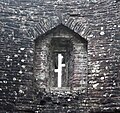
In architecture, a triangular arch typically defines an arch where the intrados (inner surface of an arch) consists of two straight segments formed by two stone slabs leaning against each other. [1] [2] In this roof-like [3] arrangement, mitre joint is usually used at the crown, thus the arch was in the past also called a mitre arch. [4] Brick builders would call triangular any arch with straight inclined sides. [5] Mayan corbel arches are also sometimes called triangular due to their shape. [6]
Since the sides of a triangular arch are experiencing bending stress, it is a false arch [2] in a structural sense (historically preceding the invention of true arches [7] and going back to Neolithic times [8]). The design was common in Anglo-Saxon England until the late 11th century ( St Mary Goslany). [1]
-
A triangular arch built using masonry ( White Castle, Monmouthshire)
-
Mayan corbelled arch
See also
References
- ^ a b Woodman & Bloom 2003, Triangular.
- ^ a b "triangular arch". The Oxford Dictionary of Architecture (4th ed.). Oxford University Press. 2021. ISBN 9780191918742.
- ^ Passmore, A.C. (1904). "Mitre arch". Handbook of Technical Terms Used in Architecture and Building and Their Allied Trades and Subjects. Scott, Greenwood, and Company. p. 228. Retrieved 2024-02-27.
- ^ "mitre arch". Oxford English Dictionary. 2023-07-01. Retrieved 2024-02-27.
- ^ Brick Industry Association] (January 1995). Brick Masonry Arches: Introduction (PDF). Technical Notes on Brick Construction. Brick Industry Association. p. 2.
- ^ Sturgis & Davis 2013, p. 121, Triangular Arch.
- ^ Nikolich 2020, p. 1862.
- ^ Harry S. Ashmore, ed. (1961). "Arch and Vault". The New Encyclopædia Britannica. Vol. 2 (14 ed.). Chicago: Sears. p. 262. OCLC 855170286.
Sources
- Woodman, Francis; Bloom, Jonathan M. (2003). "Arch". Oxford Art Online. Oxford University Press. doi: 10.1093/gao/9781884446054.article.t003657. ISBN 978-1-884446-05-4.
- Sturgis, Russell; Davis, Francis A. (2013). "Triangular Arch". Sturgis' Illustrated Dictionary of Architecture and Building: An Unabridged Reprint of the 1901-2 Edition. Dover Architecture. Dover Publications. ISBN 978-0-486-14840-3. Retrieved 2023-12-15.
- Nikolich, Dimitriye (2020-05-08). "Thrust line analysis of triangular arches". Archive of Applied Mechanics. 90 (9). Springer Science and Business Media LLC: 1861–1874. doi: 10.1007/s00419-020-01701-7. ISSN 0939-1533.


